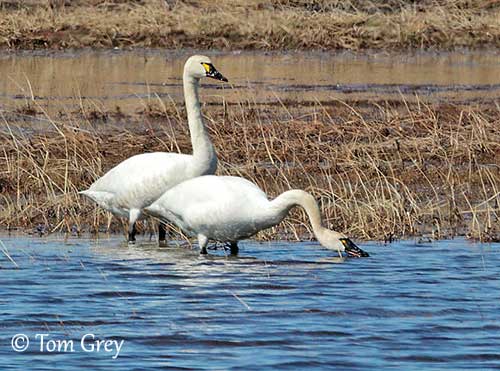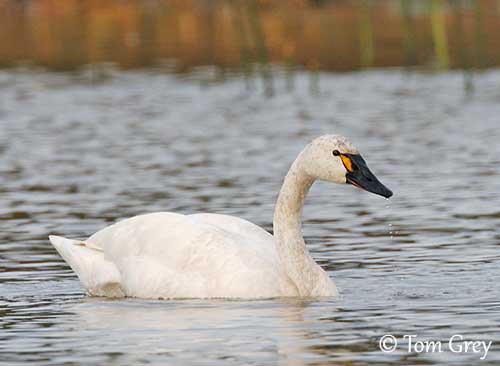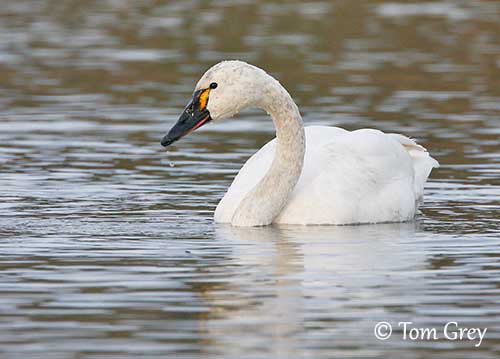
Fr: Cygne de la toundra - Cygne siffleur - Cygne de Bewick
Ang: Tundra Swan -Bewick's Swan – Whistling Swan
All: Zwergschwan
Esp: Cisne Chico
Ita: Cigno minore
Nd: Kleine Zwaan
Sd: mindre sångsvan
Photographers:
Tom Grey
Tom Grey's Bird Pictures & Tom Grey's Bird Pictures 2
Tom Merigan
Tom Merigan’s Photo Galleries
Otto Plantema
Trips around the world
Simon Tan
PBase Bird galleries
Ingo Waschkies
Bird Photography
Text by Nicole Bouglouan
Sources:
HANDBOOK OF THE BIRDS OF THE WORLD vol 1 by Josep del Hoyo-Andrew Elliot-Jordi Sargatal - Lynx Edicions - ISBN: 8487334105
GUIDE DES CANARDS, DES OIES ET DES CYGNES – de Steve Madge - Delachaux et Niestlé - ISBN: 2603013769
Animal Diversity Web (University of Michigan Museum of Zoology)
What Bird-The ultimate Bird Guide (Mitchell Waite)
Wikipedia, the free encyclopaedia
All About Birds (Cornell Lab of Ornithology)
Bird Web (Seattle Audubon Society)
Tundra Swan
Cygnus columbianus
Subspecies: Whistling Swan and Bewick’s Swan
Anseriformes Order – Anatidae Family
INTRODUCTION:
The Tundra Swan has two subspecies that were formerly, and still sometimes, considered two separate species. Cygnus columbianus columbianus or Whistling Swan is the North American counterpart of the Palearctic Cygnus columbianus bewickii or Bewick’s Swan. Both are called Tundra Swan because they breed in the moist Arctic tundra.
They differ in bill pattern, the nominate race having black facial skin and bill with a small, variable yellow patch below the eye, whereas C.c. bewickii has bright yellow bill with black tip.
They are migratory and moves S after breeding. They are currently not threatened, although some decrease is reported in North America.
DESCRIPTION OF THE BIRD:
Biometrics:
Cygnus columbianus columbianus
Length: 120-150 cm
Wingspan: 167-225 cm
Weight: M: 3800-10500 g – F: 4100-9000 g
Cygnus columbianus bewickii
Length: 115-140 cm
Wingspan: 167-225 cm
Weight: M: 4535-8390 g – F: 4300-7825 g

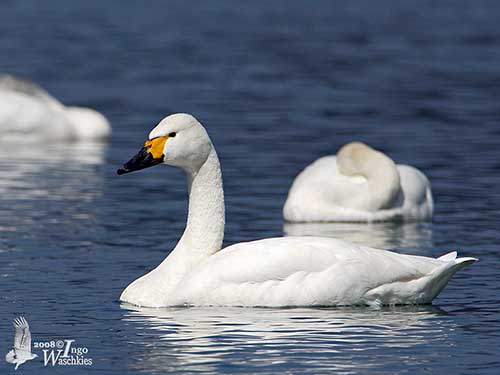
The adult of the nominate race columbianus has white plumage overall. Facial skin and bill are black with small yellow patch at bill base. This spot varies in size and is sometimes lacking and the bill appears completely black. The gape is dull red. The eyes are dark brown. Legs and webbed feet are black.
The female is slightly smaller than male.
The juvenile has greyish to pale brownish head and neck. The bill is mostly pinkish with black nail. The eye is surrounded by white eyering. Legs and feet are pinkish-grey. The second winter resembles adult.
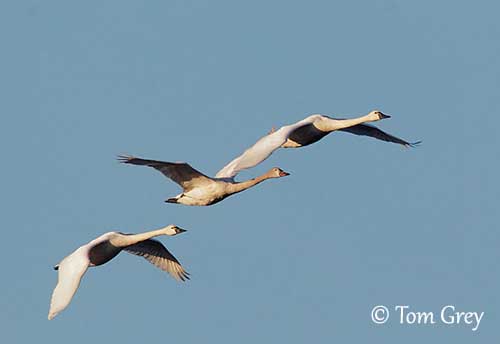
C.c. columbianus
Adults and young (centre)
The adult of the subspecies bewickii is smaller than previous but it has similar appearance except the bill. This one is slighter, with more extended yellow at base. The yellow area varies in shape and size among birds. Culmen and tip are black. The gape is pale reddish. The eyes are blackish brown. Legs and feet are black.
The juveniles of both races are similar.
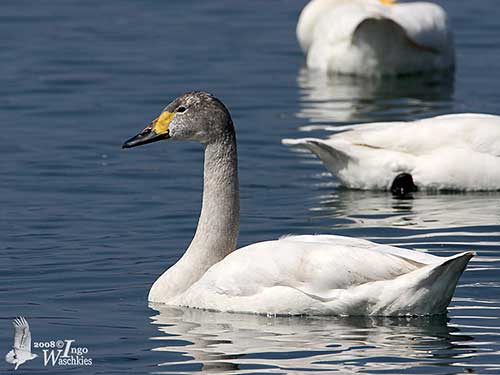
C.c. bewickii
Immature
The feathers of the adults often appear yellowish on head and neck. They are stained by water and aquatic vegetation.
SUBSPECIES AND RANGE:
The Tundra Swan of race columbianus breeds on the tundra of Arctic N America and extreme NE Siberia. It winters in W and E coasts of USA and N Mexico. It is also called Whistling Swan.
The Tundra Swan of race bewickii breeds on Kola Peninsula, E throughout Arctic N Siberia. It winters in W Europe, S of Caspian Sea and E China, Korea and Japan. It is also called Bewick’s Swan.
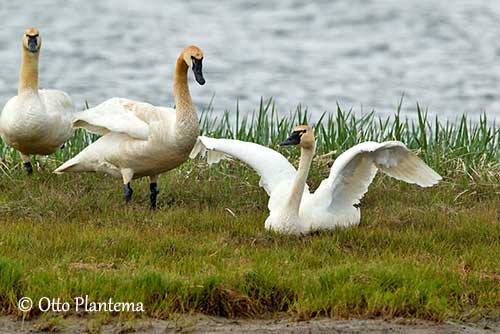
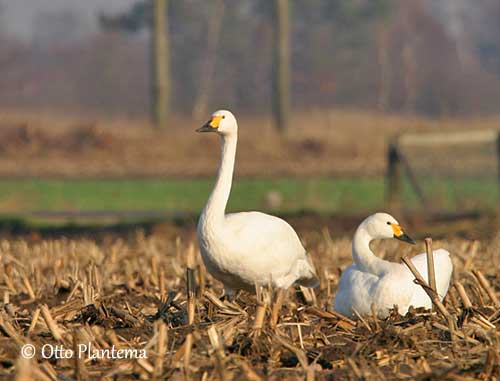
HABITAT:
The Tundra Swan breeds in the moist Arctic tundra where it frequents lakes, large rivers, flooded fields, bays and estuaries. It breeds mainly in coastal tundra.
During migration and winter, it can be seen on shallow lakes, slow-moving rivers, lowland marshy areas, both fresh and brackish waters, estuaries and adjacent cultivated fields.
The race bewickii in NW Europe frequents flooded pastures and cultivated areas during winter.
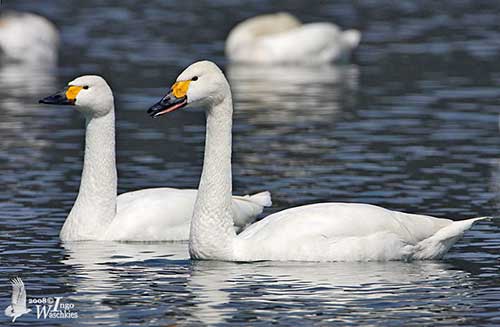
CALLS AND SONGS: SOUNDS BY XENO-CANTO
The Tundra Swan columbianus is called Whistling swan because of the sound produced by the wings during the flight.
The calls are fairly similar to those of the Canada Goose. The typical flight calls are soft, sharp “wou-wou-wou”. The usual notes “ou”, “oh” and “oo” are used in social behaviour. The resonant calls are incessant both in flight and on water or land.
While defending the nest, the adults give hissing sounds also used during aggressive encounters. The murmuring sound produced by a flock can be heard over great distances.
The Tundra Swan race bewickii produces more rapid vocalizations, usually quieter than those of nominate race, often several lower “ooo-ooo-ooo” in flight.
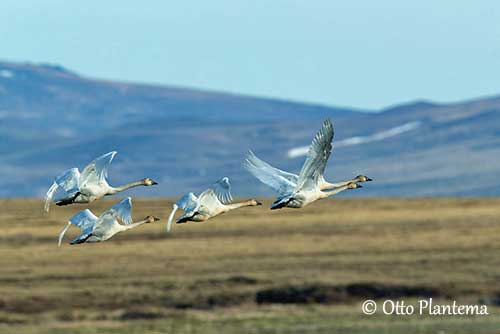
BEHAVIOUR IN THE WILD:
The Tundra Swan in summer feeds mainly on stems, seeds and roots of several aquatic plants such as sedges, pondweeds, algae and others. It also takes a few small invertebrates. Outside the breeding season, it can be seen in harvested fields where it feeds on grain including corn, barley and soybean.
The Tundra Swan forages by head-dipping and upending in shallow water. It also grazes on land by digging with the bill. By upending technique, the swan may reach almost a metre depth. Both races sometimes feed during moonlit nights.
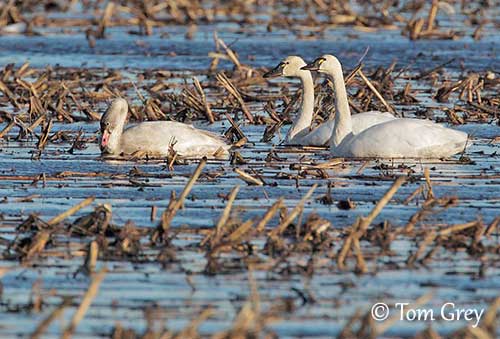
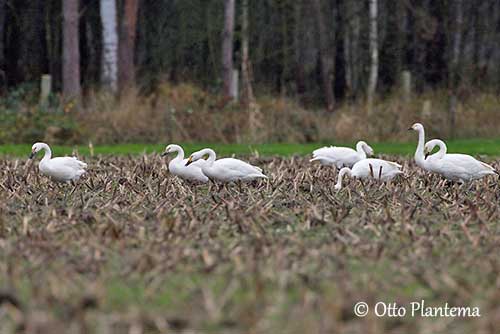
Outside breeding, they often form large flocks and can be very noisy while producing permanent low chattering. They are very gregarious except when they are nesting.
The Tundra Swan is monogamous. If a mate is lost, the other bird may remain alone during several years before to form a new pair. The nests are well-spaced over the tundra, although being in higher densities in river deltas.
The courtship displays show the birds facing each other with partly spread wings rapidly quivering. This behaviour is accompanied by loud calls while the birds bow their heads up and down. The pair establishes and defends the territory that usually includes land and large water body.
Aggressive encounters play a role in hierarchy, and the males fight to protect their families and to establish the dominance.
C.c. columbianus
Aggressive encounter
The Tundra Swan is migratory and both races move S after breeding. The eastern and western populations of North America (race columbianus) move S for wintering in W and coastal E USA and N Mexico.
The race bewickii moves S to W Europe, S of Caspian Sea and E China, Korea and Japan.
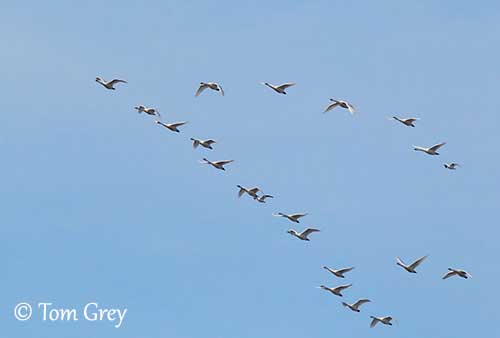
The flight is strong and direct with steady wingbeats. They migrate in flocks of up to 100 individuals or more, made up of family groups, and they may travel over long distances, about 6000 kilometres twice a year. They usually migrate in large V-shaped flight or in undulating ribbon-like flocks. They can fly up to 1500 metres above the ground during migration.
The Tundra Swan is a strong flier and takes off by running across the water surface while beating strongly the wings.
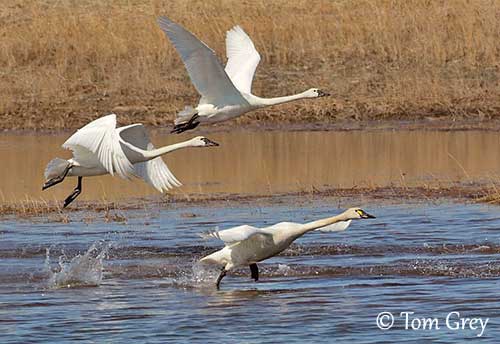
REPRODUCTION DE L’ESPECE:
The race columbianus may start to breed in mid-March according to weather conditions. It nests close to the water, pond and lake or on small islet.
The race bewickii starts to breed in late May/June and defends a territory in the arctic tundra in Siberia. It nests in scattered colonies along a stream or in estuaries.
The nest is a large mound of plant matter, often sedges, grasses and moss, placed on dry, elevated ground.
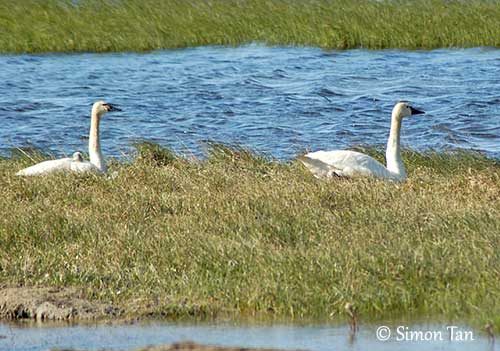
C.c. columbianus
with chick (left)
The female lays 3-5 white to yellowish eggs (slightly larger and heavier in nominate race). The incubation lasts 31-32 days, usually performed by the female in columbianus, and by the female alone during 29-30 days in bewickii. The male protects and defends the nest-site and its family. At hatching, the downy chicks are pale grey above and whiter below, with pink bill and legs.
They are cared by both parents and remain at nest for three days. They fledge about 60-75 days after hatching in columbianus, and 40-45 days in bewickii, but there are only few records and this information needs confirmation.
In both races, the young remain in family groups throughout the first winter. Adults and young migrate together with several stopovers before to reach their wintering grounds.
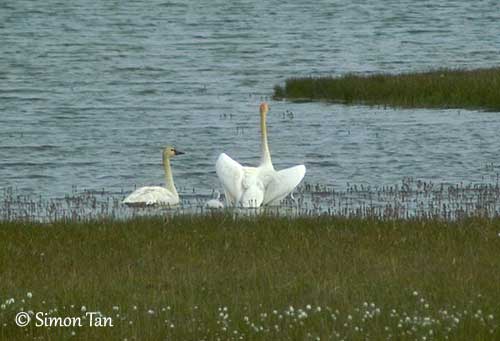
C.c. columbianus
with chick
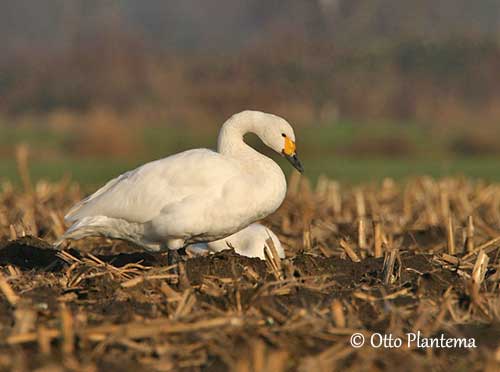
PROTECTION / THREATS / STATUS:
The Tundra Swan is threatened by habitat loss due to drainage of wetland habitats for agriculture expansion, and degradation of existing habitats by pollution and various changes in wetland management practices.
The race columbianus is hunted for sport in North America, but the species is generally hunted for consumption throughout the range.
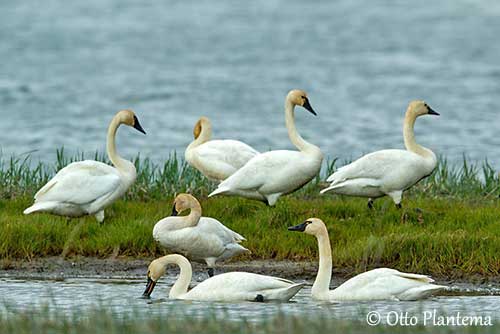
Predation by foxes, bears, eagles, skuas and Common Raven affects the breeding success. The birds are vulnerable during the moult on the breeding grounds, as they are unable to fly for some weeks.
In 2006 (Wetlands International 2006), the global population was estimated at more than 300,000 individuals (169,300 in race columbianus). Some decrease is reported but currently, the Tundra Swan is evaluated as Least Concern.
